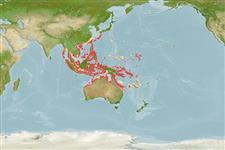>
Ovalentaria/misc (Various families in series Ovalentaria) >
Pomacentridae (Damselfishes) > Pomacentrinae
Etymology: Neoglyphidodon: Greek, para = the side of + Greek, glyphis = carved + Greek, odous = teeth.
More on author: Cuvier.
Environment: milieu / climate zone / depth range / distribution range
Écologie
marin récifal; non migrateur; profondeur 2 - 23 m (Ref. 7247). Tropical; 32°N - 25°S, 92°E - 171°E
Indo-West Pacific: Andaman Sea (Phuket), Malayan Archipelago, Indonesia, Philippines, Taiwan, Ryukyu Islands, Palau, New Guinea, Solomon Islands, Vanuatu, and northern Australia. Previously referred to as Paraglyphidodon behnii by Allen (see Ref. 4966).
Taille / Poids / Âge
Maturity: Lm ? range ? - ? cm
Max length : 13.0 cm TL mâle / non sexé; (Ref. 48636)
Description synthétique
Clés d'identification | Morphologie | Morphométrie
Épines dorsales (Total) : 13; Rayons mous dorsaux (Total) : 14 - 16; Épines anales: 2; Rayons mous anaux: 13 - 15.
Two forms: long-tailed and black as adults occur in the Andaman Sea, ranging east to western Bali and north to Japan. Second form, probably valid as N. xanthurus occur in the rest of the West Pacific and the two overlap in range on Bali's north coast (Ref. 48636). Occur in coral-rich areas of lagoon and seaward reefs. Usually solitary (Ref. 1602). Feed on algae, crustaceans, and pelagic tunicates and salps. Oviparous, distinct pairing during breeding (Ref. 205). Eggs are demersal and adhere to the substrate (Ref. 205). Males guard and aerate the eggs (Ref. 205). Diurnal species (Ref. 54980; 113699).
Life cycle and mating behavior
Maturities | Reproduction | Spawnings | Egg(s) | Fecundities | Larves
Oviparous, distinct pairing during breeding (Ref. 205). Eggs are demersal and adhere to the substrate (Ref. 205). Males guard and aerate the eggs (Ref. 205).
Allen, G.R., 1991. Damselfishes of the world. Mergus Publishers, Melle, Germany. 271 p. (Ref. 7247)
Statut dans la liste rouge de l'IUCN (Ref. 130435)
Menace pour l'homme
Harmless
Utilisations par l'homme
Pêcheries: commercial; Aquarium: Aquariums publics
Outils
Articles particuliers
Télécharger en XML
Sources Internet
Estimates based on models
Preferred temperature (Ref.
123201): 25.2 - 29.3, mean 28.6 °C (based on 2042 cells).
Phylogenetic diversity index (Ref.
82804): PD
50 = 0.5020 [Uniqueness, from 0.5 = low to 2.0 = high].
Bayesian length-weight: a=0.01905 (0.01129 - 0.03216), b=2.99 (2.84 - 3.14), in cm total length, based on LWR estimates for this species & (Sub)family-body (Ref.
93245).
Niveau trophique (Ref.
69278): 3.0 ±0.32 se; based on food items.
Résilience (Ref.
120179): Haut, temps minimum de doublement de population inférieur à 15 mois (Preliminary K or Fecundity.).
Fishing Vulnerability (Ref.
59153): Low vulnerability (10 of 100).
Nutrients (Ref.
124155): Calcium = 97.9 [49.9, 152.2] mg/100g; Iron = 0.711 [0.434, 1.149] mg/100g; Protein = 18.4 [17.2, 19.4] %; Omega3 = 0.113 [0.069, 0.180] g/100g; Selenium = 23.1 [13.3, 42.1] μg/100g; VitaminA = 87.8 [25.9, 280.8] μg/100g; Zinc = 1.57 [1.08, 2.24] mg/100g (wet weight);
